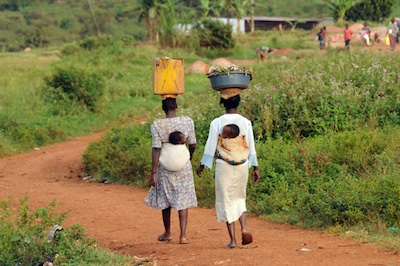Growing up in Akure was fun and I always looked forward to the summer holidays when my sibling and I would travel down to Ikogosi, the community that hosts the Ikogosi Warm Spring. The spring – a natural resource that has suffered years of neglect and sadly reminds one that government prioritises what they feel like and not necessarily what contributes to the development of the people.

A regular highlight of my stay in Ikogosi is walking down to the stream along with the others. At the time, the streams were the only source of water. Might I say that the people of Ikogosi were lucky because they had access to water for drinking and house chores. In many communities, it is the opposite.
According to UN Water, about 2.2 billion people are without access to clean water globally and the largest percentage of this number are girls and women. This does not take into accounts, the dangers faced by girls and women who travel through farm paths to get water. They are exposed to the possible dangers of rape, harassment and all forms of violence against women and girls.
It is important to note that while girls and women are saddled with responsibility of sanitation in their homes, it is the younger ones – the children who are also conscripted into doing this work. This is a heavy task for the children who are at an important stage of their physical and mental development.
These challenges would have doubled when the world began to grapple with the effect and magnitude of the coronavirus in 2020. This is not just because of increased domestic violence but due to the lockdown which heralded an economic hardship for the people – again, with women bearing the most of the disadvantages.
To bring home the dangers women and girls are exposed to due to lack of access to portable water, not only as the ones expected to do all the sanitation-related chores but also as the ones with less access to social goods, about 44 million pregnant women have sanitation-related hookworm infections in developing countries.
Today, as the world gathers physically and virtually to celebrate women across the globe, I am forced to ponder, is there women development without access to portable water? This question begs for urgent answer in Nigeria at this time that the government at all levels are negligent in the provision of public utilities that can make life easier for girls and women.
The International Women’s Day (IWD) is a global day set aside for the celebration of women’s achievements in all spheres of life as they continue to break glass ceilings socially, economically, culturally and politically. The annual IWD also provides the opportunity to bring issues that affect women to the front burner as a way to achieve gender equality.
Considering the vision of the International Women’s Day, access to portable water as human right to meet the hygiene and domestic needs of girls and women is critical and must be looked at, as a pathway to national development.
In 2010, the United Nations declared water as a right. Through Resolution 64/292, the United Nations General Assembly explicitly recognised the human right to water and sanitation and acknowledged that clean drinking water and sanitation are essential to the realisation of all human rights.
The concerns around lack of access to water are quite enormous and the numbers continue to strike the wrong chord everywhere. Though no quantitative numbers for women and the effects of lack to water, the UNICEF reported that 70, 000 children under the age of 5 die annually in Nigeria due to diseases related to lack of water and proper hygiene.
The WEAREWATER project in 2017 confirmed that the extrapolation of data based on quantitative figures available means that more than 40 billion hours are wasted yearly in the journey to and fro water sources in Asia and sub-Saharan Africa.
The hours spent in search of water could be channelled into more productive activities that will enhance the quality of life of girls and women so that they can reach their full potentials.
If this trend must be reversed and the targets of the Sustainable Development Goal 6 will be achieved by the 2030, everyone must get in line now and put in the effort to ensure that water as designated by the UN as a right is physically accessible, safe, sufficient, and not a threat to the development of girls and women.
Government at national and sub-national levels must also move beyond the annual rhetoric of how women must be given a fair role in our society and actively invest in services that will enhance their capacity, improve their chances of becoming who they dream to be and encourage them to actively contribute to nation building in all forms.
Through gender-responsive budgeting, government at state levels can focus on quality public services that will meet women’s needs, contribute to achievement of gender equality, and end violence and harassment against women.
As the world chooses to challenge today for better, fair, and equitable society, women in leadership positions must continue to rally their male counterparts, mobilise resources and consolidate on their gains to resolve the looming global water crisis, and save public water utilities that will serve their purposes (and that of everyone else) from corporations that are looking to plunder them and hold government accountable at all levels.
By Abayomi Sarumi, Corporate Accountability and Public Participation Africa
